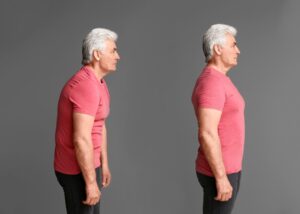 Posture. It seems like such a simple thing, yet we as humans seem to have a hard time getting it right. How many times have you been told to “stop slouching” or “stand up straight”? We’ve all heard the quips and warnings, but does bad posture cause back pain? Research replies with a resounding “yes.” Maintaining poor posture for a long period of time has been linked to many conditions, including musculoskeletal disorders. Of course, the first musculoskeletal disorder that comes to mind for most when considering the consequences of a slouch is the broadly-labeled “back pain.” This begs the question: we know that it does, but how can poor posture result in back pain and eventually trigger the need for back pain treatment?
Posture. It seems like such a simple thing, yet we as humans seem to have a hard time getting it right. How many times have you been told to “stop slouching” or “stand up straight”? We’ve all heard the quips and warnings, but does bad posture cause back pain? Research replies with a resounding “yes.” Maintaining poor posture for a long period of time has been linked to many conditions, including musculoskeletal disorders. Of course, the first musculoskeletal disorder that comes to mind for most when considering the consequences of a slouch is the broadly-labeled “back pain.” This begs the question: we know that it does, but how can poor posture result in back pain and eventually trigger the need for back pain treatment?
How Do We Define Posture?
In simplest terms, posture is how you position your body. Whether you’re completely stationary or performing an activity, you’re always engaging in some form of posturing. Take this moment to pay attention to how you’re holding your body right now. Is your neck bent or straight? Are your shoulders raised or at rest? Is your spine twisted at all? These are all elements of posture.
What Makes Posture Good or Bad?
 There are many ways in which poor posture can present itself, so let’s first touch on what makes a good posture. Generally, good posture is one that keeps the spine properly aligned. Imagine a line running from the top of your head to the base of your spine. That line should be kept as straight as possible, keeping in mind, of course, the natural curvature of the spine. If that line bends too far in any direction, you could end up putting strain on your muscles, ligaments, or even your bones. As mentioned before, this can lead to various musculoskeletal ailments, including back pain.
There are many ways in which poor posture can present itself, so let’s first touch on what makes a good posture. Generally, good posture is one that keeps the spine properly aligned. Imagine a line running from the top of your head to the base of your spine. That line should be kept as straight as possible, keeping in mind, of course, the natural curvature of the spine. If that line bends too far in any direction, you could end up putting strain on your muscles, ligaments, or even your bones. As mentioned before, this can lead to various musculoskeletal ailments, including back pain.
Now for the part that may alarm you: remember when we asked you to check your posture just a little while ago? Did you notice any of those bodily details before we asked you to pay attention to them? More importantly, has your body shifted any since that check? In the same way that we stand up a little straighter when someone points out our slouch, we tend not to notice our own bad posture until our attention is directed to it, until it becomes more severe, or until it causes pain.
What Are Some Examples of Poor Posture?
 Knowing the basics of what makes poor posture is one thing, but knowing the common signs of poor posture and when to correct it can be enough to improve your musculoskeletal health. However, do keep in mind that if you already have severe back pain, posture correction may only be one step towards achieving relief. You might need additional treatment for back pain, such as chiropractic care, physical therapy, and more.
Knowing the basics of what makes poor posture is one thing, but knowing the common signs of poor posture and when to correct it can be enough to improve your musculoskeletal health. However, do keep in mind that if you already have severe back pain, posture correction may only be one step towards achieving relief. You might need additional treatment for back pain, such as chiropractic care, physical therapy, and more.
With that in mind, here are three examples of poor posture that may end up causing you undue pain later on.
Leaning on One Leg
Have you ever caught yourself leaning too hard on one leg? It often happens when we start feeling tired or restless, and we start to shift our weight from one leg to another in order to stay awake and upright. If you’ve worked retail and stood at a cash register for an extended period of time, this may sound familiar to you. At the moment, it may feel more comfortable than standing upright. Unfortunately, this common mistake can lead to strain on the lower back. Let’s say you lean on your left leg. Over time, this increased strain on your left hip and twist of your pelvis will result in your spine itself twisting to the left, as well as increased weakness of the glutes. All of this extra strain in the lower portion of your body will inevitably translate to undue strain on the lower back, which in turn leads to lower back pain.
The Forward Stoop
Also known as flat back, the forward stoop is a big cause of back pain. Chances are, this is the one you were nagged for as a kid. Maybe you’re just in a bad mood, or maybe you’re just tired. In any case, standing with your pelvis tucked in and your upper body leaned forwards will only cause more pain the more you do it. As you stand in this position for long periods of time, the strain on the muscles in and around your lower back will increase as they try to tilt the pelvis back into place. Over time, this can lead to lower back pain, upper back pain, and, as the name suggests, a loss of curvature in the spine itself. This in itself can lead to difficulty standing upright, as well as an increase in fatigue. In severe cases, surgical intervention may be the only option, so it’s best to correct it early on.
Sitting
No, we’re not talking about slouching while sitting, though that can also lead to back problems later on. Just sitting at your desk for extended periods of time every single day can lead to back pain, and thousands of Americans have been proven to do just that. The number of sedentary Americans is likely even higher than statistics can report, especially among those who work sedentary jobs, as well as the elderly and disabled. That and the looming pandemic has made people very skittish about leaving home these past few years. In short, a lot of Americans spend a lot of time sitting, and it’s wreaking havoc on their spinal health.
So, what does incessant sitting do to your back? When you sit, your back muscles are no longer working to keep you standing, and they weaken from underuse. This not only causes you to experience muscle fatigue and pain in the back, but it also means that the muscles are less able to support the weight of your upper half, which puts more pressure directly on your spine. This leaves you at risk for not just generalized lower back pain, but also problems with the spine itself, including damage to the discs in between your vertebrae. To add insult to injury, the sitting position promotes very poor circulation to the rest of the body, which in turn decreases the flow of nutrients and oxygen to the muscle and nerve cells of the back.
How Do I Maintain Good Posture?
Keeping good posture should be easy to do once you know how to stay aware of your body. Keep your head and spine aligned, try to avoid unevenly distributing your weight, and if you find yourself sitting more often than not, try to get up and take short “activity breaks” to restore circulation and exercise the muscles in your back. However, if you’re finding it difficult to maintain good posture, don’t be afraid to seek help. Our Lithia Springs chiropractors will be more than happy to help you get on the road to a better posture.
Sources
- Hakam, Mulia, and Norma Nabilah. “Impact Of Work Posture On Musculoskeletal Disorder In Nurses.” The 3rd Joint International Conference. Vol. 3. No. 1. 2021.
- Stephens, James, and Susan Hillier. “Evidence for the effectiveness of the Feldenkrais method.” Kinesiology Review 9.3 (2020): 228-235.
- Ussery, Emily N., et al. “Joint prevalence of sitting time and leisure-time physical activity among US adults, 2015-2016.” Jama 320.19 (2018): 2036-2038.
